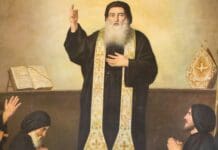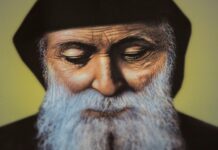By Phillip Rolfes
Just last week “The Catholic Talk Show” aired an episode entitled What Are the Eastern Catholic Churches?
Although I hold no delusions that the hosts chose this topic in part because of the articles I’ve been writing for their blog here at uCatholic, I can’t help but feel like they’ve strayed into my territory…
All joking aside, it’s a wonderful episode, and I highly encourage you to click the link right now and go listen to it. Don’t worry. I can wait…
Okay. Have you listened to the show?
Great! Because in the rest of this blog post I’d like to further nuance—and perhaps correct—a few of the things they talked about.
Diving Deeper Into the East:
- Eastern Rite Catholic Churches?
A few times the hosts use the phrase “Eastern Rite Catholic Churches.” This struck me as quite odd. The phrase assumes that there is only one Eastern Rite. But the hosts themselves quite rightly pointed out that there are several families of rites in the East—the Byzantine (Greek), the Antiochian (Syriac), the Alexandrian (Coptic and Ethiopian), the Armenian (Armenian) rites. The proper phrase to use when referring to the Catholic churches of the Christian East is simply Eastern Catholic Churches. - Andrew Established the See of Constantinople?
At one point in the episode the discussion turned to the apostolic roots of each of the five major patriarchates. Although Jerusalem, Antioch, Alexandria, and Rome were certainly established as centers of Christianity by one of the Apostles, historians debate whether or not Andrew himself was ever in what would become Constantinople. Some historians speculate that this legend was started so as to lend an air of legitimacy to the ecclesial power and influence that the Church in Constantinople was beginning to wield over the churches within the Byzantine empire. - Greek East, Latin West
This part made me chuckle. Fr. Elias Rafaj made the joke that initially even the West spoke Greek (which is why you still hear Kyrie eleison, Christe eleison in the Mass). But truth be told, there were really three major families of languages in the early Church, as represented by the inscription above Christ on the cross. Greek and Latin were certainly two of those languages. But Syriac, a dialect of Aramaic (the language Jesus spoke), is also one of the ancient languages of the Church. It’s interesting to note that the difference in nuance between Greek and Syriac is at the root of several of the earliest heresies (Nestorianism and Miaphystism for example). - Leavened Bread in the East, Unleavened Bread in the West?
When the hosts mentioned that the Eastern Catholic Churches use leavened bread in the Divine Liturgy, Fr. Elias rightly pointed out that not all the Eastern Catholic Churches use leavened bread. In fact, the ancient tradition of the Armenian Catholic Church is to use unleavened bread. But what really jumped out at me as I listened to this was the realization that all of the Eastern Catholic churches with Semitic roots (i.e. the churches of the Syriac traditions) use unleavened bread. This means that those churches that are closest in thought and culture to the Judaism of Jesus’ day are using unleavened bread like Jesus would’ve used in His Passover feasts. - The Sign of the Cross
It’s true that in the Byzantine East the Sign of the Cross is done by touching the forehead, then the chest, then the right shoulder, then the left shoulder. But this is not true of all of the Eastern Catholic Churches. Most of the other Eastern Catholic Churches touch their left shoulder and then their right shoulder. But we typically hold our hands in the Byzantine fashion—thumb touching the first and middle fingers, and ring and index fingers pressed to the palm. This is to symbolize the Trinity as Three-In-One, and the two natures of Christ, who descended from heaven to earth. - A Spoon for Communion?
Some Eastern Catholic Churches use a liturgical spoon to distribute Holy Communion. But this is not true of all Eastern Catholic Churches. It’s not even true of all Churches of the Byzantine tradition. The Melkite Greek (Byzantine) Catholic Church, for example, does not use the liturgical spoon. Nor does the Maronite Catholic Church. No less than Fr. Robert Taft—the noted Byzantine liturgical historian—pointed out that the use of the liturgical spoon was initially denounced as an innovation and liturgical abuse before it was gradually accepted. - Emphasis on the Epiclesis
As Fr. Elias rightly pointed out, the Eastern Churches have never felt the need to pinpoint the precise moment when the bread and wine become the Body and Blood of Christ. Fr. Alexander Schmemann, in his book For the Life of the World, says that for the East it’s the entire liturgical action that “confects” the Eucharist. But, when pressed to pinpoint the exact moment this takes place, most Easterners emphasize the calling down of the Holy Spirit (the epiclesis) and not the Words of Institution. That’s why we have no problem with the Anaphora of Addai and Mari, which has no explicit Words of Institution.
Did you enjoy the episode? I know I sure did, and I sincerely hope that “The Catholic Talk Show” hosts more Eastern Catholics and Eastern Catholic related topics in the (very near) future. In the meantime, stay tuned to uCatholic’s blog, where I’ll continue posting more about the Eastern Catholic Churches.
 Phillip Rolfes is That Eastern Catholic Guy. A “canonical convert” from Roman Catholicism to Maronite Catholicism, Phillip loves researching and sharing the rich traditions of the Christian East. He lives in Cincinnati, OH. with his wife and four children, and is parishioner at St. Anthony of Padua Maronite Catholic Church.
Phillip Rolfes is That Eastern Catholic Guy. A “canonical convert” from Roman Catholicism to Maronite Catholicism, Phillip loves researching and sharing the rich traditions of the Christian East. He lives in Cincinnati, OH. with his wife and four children, and is parishioner at St. Anthony of Padua Maronite Catholic Church.


















Make 6150 bucks every month… Start doing online computer-based work through our website. I have been working from home for 4 years now and I love it. I don’t have a boss standing over my shoulder and I make my own hours. The tips below are very informative and anyone currently working from home or planning to in the future could use this website……… Details Here
St. Joseph, terror of demons, cleanse this site from insensitive mischievous abuse. Amen.
St. Jean-Baptiste-Marie Vianney, pray for us.
St. Louis-Marie de Montfort, pray for us.